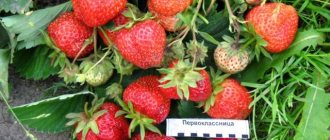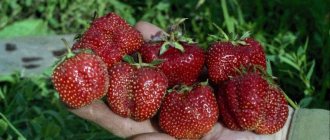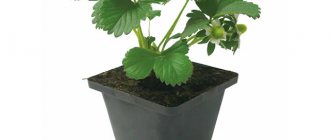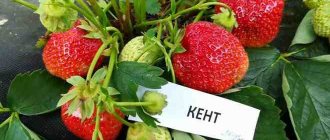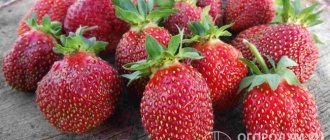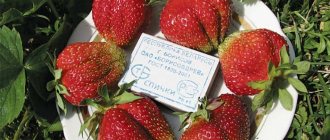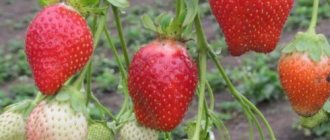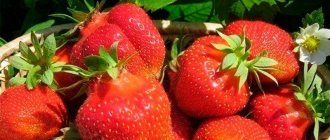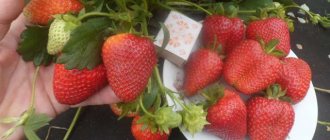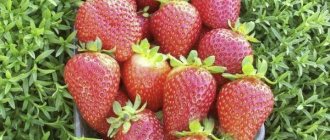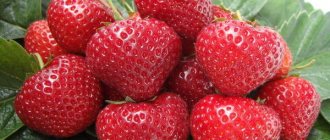Disease and pest control
The following pests are most dangerous for remontant strawberries:
- Aphids - to combat them, you can treat them with garlic infusion. To prepare it, infuse 2 heads of garlic in 3 liters of water for a week.
- Slugs - to protect against them, the bed can be surrounded by a ditch with lime or ash, tobacco or pepper.
- Weevils and ticks - treatment with Karbofos, Actellik and other drugs is used against them according to the instructions.
To prevent the development of diseases, use the following spraying schedule:
- in early spring it is necessary to treat the beds with 2–3% Bordeaux mixture;
- before flowering, the preparations “Topsin-M”, “Quadris” and similar fungicides are effective;
- Fungicides are used twice more, 2 and 4 weeks after flowering.
Important! The area for growing strawberries must be changed every 4 years.
Reviews
- Ekaterina, 45 years old: “I started growing Vikoda 5 years ago. During this time, I managed to significantly expand the plantation of berry bushes, because this variety is characterized by increased tendril formation. In addition, the variety is characterized by high yield, since I managed to collect 1.2 kg of fruit from one bush. All of them are distinguished by their sweet taste and juiciness. What I also liked was the ability to grow on any soil. The main thing is that the place is well lit by the sun. You also need to fertilize regularly. The yield of the bushes depends on them.”
- Ksenia, 34 years old: “I started growing Vikoda only 3 years ago. In the first year after planting, strawberries did not please me with a special harvest, but the next year I was able to get 1 kg of berries from one bush. They can be used for any purpose, as a result of which I call this variety universal. The berries are great for compote, jam and winter freezing. The bushes are not picky when it comes to caring for them, but it is important to take care of watering. It should be regular and plentiful. For this I use a watering can with a sprayer. One bush takes about 3 liters of water.”
It is also worth reading information about existing reviews about the Darselect strawberry variety.
Vikoda is a universal strawberry variety that, if grown correctly, can reward you with a rich harvest. In addition, the bushes have high winter hardiness and strong immunity to parasites and pests. It bears fruit on almost any soil, but it is important to fertilize it on time. If you don’t do this, then you can forget about a high yield.
Subsequent care of seedlings
Mandatory care of plantings includes watering, fertilizing, loosening and weeding.
Watering
The intensity of irrigation depends on the climate and the amount of precipitation during the season. Don't let the soil dry out to dust. It is also impossible to allow water to stagnate in the soil. Irrigate the bushes as needed.
A slightly moist substrate always indicates high-quality regular watering.
Water for irrigation must be warm. Moisten the plantings in the morning or evening, during the period when the sun does not intensely affect the plants. Experienced gardeners recommend collecting water in the morning and leaving it in an open container under the sun. So by the evening the water will warm up and settle at the same time.
Important! To better retain moisture in the soil, it is advisable to mulch the plantings. Farmers use sawdust, hay or dry leaves as mulch.
Top dressing
The frequency of fertilization for the Kama variety is standard. The feeding scheme is as follows:
- at the beginning of the growing season - nitrogen-based preparations;
- at the time of fruit formation - complex potassium-phosphorus supplements;
- after harvest - organic products.
The choice of product depends on the type of soil. Keep in mind that the crop accepts potash fertilizers well. Apply more potassium to the soil than standard strawberry growing practices indicate. Acceptable preparations include potassium sulfate, liquid manure, and wood ash.
Loosening and removing weeds
After each watering, the substrate must be loosened. If you do not loosen the soil, the wet layer will dry out as a crust. The root system will receive less oxygen, which is why the bushes will develop more slowly. Also loosen the soil after rain. If drought suddenly sets in after precipitation, without loosening the soil the result will be no less disastrous.
Weeds are removed as they appear. Plants pull elements from the soil that strawberries need, so they need to be removed from the rows in a timely manner. In addition, the presence of weeds worsens the aesthetic appearance of the beds and complicates harvesting. It is convenient to remove weeds along with loosening. This is how weeds emerge from the soil along with their roots.
How to plant the Vikoda variety correctly?
Before planting strawberries, you need to remember three basic rules, with the help of which this variety will give a huge harvest.
Rule #1
The Vikoda variety is very light-loving . A large harvest can only be obtained from those areas where the sun shines for a long time and there is no constant shade. An excellent option would be a bed that is well protected from the wind and with sufficient sunlight.
Rule #2
Abundant watering is the key to success . This variety is believed to be resistant to both frost and hot weather. But do not forget that Vikoda is a very moisture-loving plant. A sufficient amount of moisture in the soil allows fruit to form quickly.
Rule #3
In order for strawberries to be large and sweet, the soil in which they will grow must be properly fertilized. Fertilizers should include both organic and mineral components.
Advice. Strawberries do not like large amounts of nitrogen in the soil.
Agrotechnical techniques for growing berries
The main parameters that will ensure the fruiting of strawberries and protect them from diseases.
Selecting a site for planting and preparing the soil
Strawberries prefer light loam, black soil and gray forest soils; they least like clay soil. Groundwater should be no closer than 60-80 cm. The acidity indicator is optimal within the pH range of 2.7-6.2. Cereals, onions, garlic, marigolds, and petunias are considered good predecessors. You can grow strawberries in one place for 3-4 years.
The yield of Vikoda strawberries will depend on the type of soil.
Before planting, you need to destroy the weeds on the site. Then add organic fertilizers and dig. It is necessary to prepare the soil for spring planting in the fall. When planting in summer and autumn, the necessary work must be carried out a month before planting so that the soil has time to settle, otherwise the roots of the seedlings may be exposed, which will have a detrimental effect on the development of the plant.
Selection of quality seedlings
The harvest largely depends on the quality of planting material. Seedlings of this variety should be distinguished by powerful, healthy plants and have:
- root collar with a diameter greater than 6 mm;
- fibrous root system, in root shoots more than 7 cm;
- 3-5 leaves and a whole apical bud.
Stages of the planting process
Seedlings must be planted in early spring or late August - early September. It is better to plant in spring when the snow has melted and the earth has warmed up.
It is important not to delay planting in the fall, as the seedlings will not have time to take root and will die from frost.
Vikoda strawberry seedlings are planted in early spring or at the end of August.
Choose a cloudy day for planting. In hot weather, seedlings need to be shaded for two weeks after planting.
Form holes in the garden bed, keeping a distance of 40 cm between them, and 50-60 cm between the rows, since with denser planting the plants will experience a lack of light and nutrients. Pour water into the dug holes and begin planting, freely positioning the roots of the plant, without bending them and covering them closely with soil, which will allow the seedlings to take root faster.
It is important that the root collar, on which the growth point is located, is on the surface of the earth.
Compact the soil well and moisten it a little.
Mulch with humus to prevent the formation of a crust on the surface of the earth.. https://www.youtube.com/embed/lKvo4W2ilj4
History of the variety's creation
Breeders from the Dutch plant, while working on the company's experimental plots, randomly bred a new variety of late-ripening strawberries, which they gave the name “Vikoda” and issued a European patent for this crop and its distribution in different countries of the world.
For many years, Russian gardeners have been following with interest new products among Dutch strawberry varieties, which are developed by Dutch specialists from. Many of the varieties of strawberries offered by this company are included in the Russian State Register and have been successfully growing and bearing fruit in Russia for a long time.
But Vikoda is still not included in the Russian register, but in 2002 it was included in the plant register of Belarus, where this strawberry is recommended for growing in garden beds throughout the country.
In Russia, strawberries of this variety are grown in the Moscow region, the middle zone, in the Urals and Siberia.
Description of the variety
Strawberry Furor belongs to the remontant varieties of universal use. Recommended for growing in summer cottages and production areas. The boundaries of cultivation are expanded by the possibility of the hanging option and the use of hydroponics.
Bushes
Neat bushes have great growth energy. The leaves are large, round-oval, toothed. Doesn't show much mustache. The flowers are white, bisexual. Peduncles are elongated, with multiple primordia. The fruits bend them to the ground. A distinctive feature of the variety is the rapid growth of new flower stalks.
Berries
Beautiful large berries have a regular elongated conical shape. There may be no neck at all. Toward the end of the season, the strict one-dimensionality of size and shape may deteriorate. The average weight of berries is 35 g, individual specimens may be larger. The shiny, varnished skin is strong and bright red. The achenes are immersed in the fruit and are practically not felt. The red flesh is juicy, tight, without crunch.
Sweetness harmoniously combines with sourness. Taste qualities do not change by the end of the season, and prolonged rains do not have a significant effect on the taste. To obtain harmony of taste, the gardener is required to timely monitor the fertility of the soil and the presence of all microelements in it.
Productivity
Fruiting is continuous, from May to October, occurring in several waves between which there may be breaks of about two weeks. Productivity is on average 1.0-1.4 kg. from the bush. This is a real figure that even a novice gardener can get.
Main characteristics
When considering the description of the Vikoda strawberry variety, photos, reviews, you should first dwell on the characteristics of the crop. In the process of crossing, Dutch breeders obtained strawberries with excellent taste. A powerful, lush bush grows to medium height. Strong shoots are capable of holding berries with an average weight of 50–70 g. It is not for nothing that the Vikoda variety was called noble. The first fruits grow weighing about 120 g.
Despite its gigantic size, the berry is dense inside. The pulp is juicy, tender with a cherry flavor. When eating strawberries, the acidity is clearly felt, but there is also enough sweetness. The berry has a spherical shape. On large fruits, ribbing with irregularities is observed. Vikoda is considered a late variety. Cleaning begins at the end of July.
Rules for planting garden strawberries
Before planting, of course, you need to select a site. It should be in a sunny place. Also, the proximity of groundwater to the surface of the earth is unacceptable.
Once the site has been selected, it is prepared. This is done 2 months before the planned planting. Preparatory work includes:
- Clearing the area of grass.
- Digging of soil to a depth of 30 cm.
- Fertilizing the site. About 6-7 kg of humus is consumed for each m2.
Garden strawberries can be planted both in autumn and spring. Naturally, gardeners prefer autumn planting, since in this case they can get a harvest already in the next season. However, it is not always possible to do this. For example, in the cold regions of our country, strawberry seedlings need to be planted in the spring, since when planted in the fall, they most likely will not have time to get stronger by winter in a new place.
Regardless of when Onda garden strawberries are planted, the planting pattern will be the same:
- Planting holes are dug out. They are arranged in a checkerboard pattern.
- Leave 25 to 40 cm between plants. Too dense plantings are not recommended, as in this case the plants may encounter poor natural aeration, which will make them more susceptible to fungal diseases.
- Row spacing is approximately 60-70 cm.
- When the holes are ready, a mound of fertile soil is formed in the center. The root system is carefully straightened along this mound. It is also worth noting that the seedling must be placed strictly vertically in the hole.
- When the seedling is conveniently located in the hole, it is sprinkled with earth. It is compacted.
- When the work is completed, each plant is watered. About 1 liter of water is spent on 1 bush.
Preparing soil and seedlings
According to gardeners, Vikoda strawberries love medium acidity soil. It is optimal to bring the pH to 5–6.5. The purchased seedlings are in no hurry to be sent to the garden. First, the plants are hardened off by taking them outside during the day. If seedlings are planted under film, it is enough to keep them in a cool place for at least two days. Hardening will help the Vikoda variety to quickly adapt to the external environment.
When preparing new Vikoda seedlings, you should not rush to uproot all the old strawberries. Only part of the bushes are removed from the garden bed in a checkerboard pattern. You should end up with a pattern where young Vikoda is surrounded by old strawberries. Large bushes with broad foliage will protect new plantings from the wind.
Agrotechnics of cultivation
For good harvests, you must follow all the rules for planting and caring for strawberries.
Landing
Suitable soil types for Vikoda strawberries:
- loamy;
- chernozem;
- gray forest soils.
The optimal humidity for growing crops is 65-70 percent. Soil acidity should be 2.7-6.2. Groundwater should pass no closer than 60 centimeters to the surface. It is good to plant strawberries in places where petunias, onions, garlic or cereals previously grew.
Basic principles for selecting seedlings:
- root collar - more than six millimeters in diameter;
- root shoots should be more than 7 cm;
- the plant should have about three leaves and a whole apical bud.
Important! Before planting, seedlings are stored for 2 days in a cool place to acclimate the seedlings to the climate. You can cut off part of the root to prevent diseases and the growth of lateral shoots, as well as to protect against pests
Landing rules:
- plant seedlings in early spring or late August - early September;
- It is advisable to choose a cloudy day or you will need to shade for 2 weeks;
- form holes at a distance of 40 cm, retreating half a meter between the rows;
- pour water, place the roots neatly and loosely, sprinkle tightly, the growing point should be above the ground;
- the soil is compacted and moistened;
- mulch with humus to prevent crust formation.
Before planting, remove the weed. Organic fertilizers are applied and dug up. Preparations have been made since the fall. If you plan to plant in late August - early September, then prepare the soil a month in advance so that it does not sag and the roots are not exposed.
Care
To obtain rich harvests and protect strawberries from pests, preventive measures are necessary.
Basic measures for caring for crops:
- Watering. In spring, moisten the soil once every 7 days. During the flowering and fruiting period, water with warm water 2-3 times a week. In the fall, continue watering in the same mode until it gets colder;
Additional Information. It is convenient to do drip irrigation or sprinkling for strawberries (a mobile method by placing sprinklers - spraying devices) in the right places.
- In order to avoid cracking and drying out of the soil, mulching with straw or film is used;
- Fertilizers are applied in the spring. Organic and mineral supplements with a set of microelements are required. Manure and humus are considered one of the oldest fertilizers. Also used: chicken manure, fermented milk, bread, nettle fertilizers. From mineral substances: sulfates, saltpeter, urea, nitroammophoska;
- Weed control. Regular weeding is carried out as necessary to avoid the use of chemicals;
- Diseases and pests. It is necessary to inspect the leaves and fruits. If diseases are detected, the plants are treated. Basic remedies: for powdery mildew and rot they are treated with fungicides, everything affected is removed; for nematodes and strawberry mites, chemicals and folk remedies are used;
- Preparing for winter. If the roots come out, they are buried in soil. The bushes themselves are covered with straw and spruce branches.
Features of reproduction
There are several options for growing strawberries:
- Seeds. They are mainly used to obtain new crops. It is not suitable for this type, since the fruits and leaves will be small and undergrown;
- Usami. Peduncles are partially removed. When the strawberries bear fruit, you need to choose more fruit-bearing bushes. After harvesting, the rosette is slightly pressed into the ground. Later, the formed bushes are planted. This time falls at the end of summer, beginning of autumn;
- Dividing the bush. Used less frequently. Choose the healthiest bush, which has more than one top with a rosette. Dig out and carefully separate. Varietal material is planted in prepared holes, the roots are well sprinkled and watered. They also separate the rosette from the main bush and plant it.
Compliance with all care rules guarantees a harvest next year after planting.
Types of reproduction
Vicoda reproduces both by tendrils and by seeds or division.
Usami
The plant has few tendrils, therefore, for the purpose of propagation, it is advisable to partially tear off the flowers, which will direct the force to proper development.
After harvesting, straighten the mustaches with rosettes from the most fruitful bushes, sprinkle the rosettes themselves with earth, leaving the hearts open. At the beginning of autumn, the bushes are planted in a prepared place.
Dividing the bush
Strong, healthy bushes with several tops with rosettes are dug up and the rosettes are separated. New bushes are planted so that the roots are completely underground, water. After planting, these bushes can bear fruit in the first year.
Seeds
This is the most unpopular method of breeding Vikoda, and usually it does not make sense.
When using seeds for propagation, it is difficult to predict which maternal properties will be transferred to the new plant. There is a risk of getting low quality berries.
Reproduction
The Vima Zanta variety is very easy to propagate with the help of numerous tendrils. Whiskers or, in other words, daughter rosettes are formed throughout the growing season. On average, one well-developed mother bush can produce up to 15-20 young plants. Most of the mustaches are formed by 2-3 year old bushes. As we age, conformation gradually decreases.
The advantages of reproduction with a mustache include:
- Full preservation of varietal characteristics.
- Almost 100% survival rate.
- Ease of reproduction.
To obtain the maximum number of runners, all peduncles are removed from the selected plants. This allows you to get the maximum number of daughter sockets. July whiskers are best suited for propagation. They manage to take root well before the onset of frost and therefore overwinter with virtually no losses.
For reproduction, it is best to use first-order whiskers. If necessary, the others can be used, but they are usually much smaller and weaker. For faster rooting, selected shoots are pinned to the ground and lightly hilled. As soon as the mustache takes root and begins to grow, they begin to be planted.
The rooted mustache is dug up using a scoop or small spatula. The dug plant is transferred to a pre-prepared planting bed.
When planting young bushes, it is necessary to monitor the depth level of the growing point. It should be slightly above ground level. Excessive deepening or elevation of the heart will lead to the death of the bush.
After planting is completed, the bed is watered abundantly, and the soil surface is mulched with a layer of straw, peat or humus. To create greenhouse conditions, seedlings are covered with a layer of non-woven material. It effectively protects from the sun while maintaining a constant level of humidity.
Reproduction methods
Among the methods of propagation of strawberries there are : mustaches, dividing the bush and seeds.
Usami
The most famous method of obtaining planting material is growing from vegetative shoots - mustaches. The variety produces a small number of rosettes, so the flower stalks should be partially removed in order to direct the plant’s energy to reproduction.
At the moment of fruiting, mark the most berry-bearing specimens . After harvesting, straighten the mustaches on which the rosettes have formed, and lightly press the rosette into the ground and sprinkle it with earth so that the hearts remain free. At the end of summer or in September, plant new bushes with developed roots in a permanent place.
Dividing the bush
The method of dividing the bush is used less frequently. But it is also effective and worth using. To do this, you need to identify healthy and strong bushes that have more than one top with a rosette . Dig out selected specimens. Carefully separate the sockets from each other. Proper division guarantees the production of full-fledged plants capable of bearing fruit in the first year.
Dividing a Vikoda strawberry bush
Plant new bushes in prepared planting holes so that the roots of the plants are completely covered, otherwise they will dry out quickly. Then water well.
You can separate the rosette from the main bush and transplant it to a separate place where it will grow and develop independently.
Seeds
Seed propagation is used to obtain new varieties. In the case of the Vikoda variety, it is not worth propagating using seeds , since the properties of the mother plant are transferred inconsistently. There is a possibility of getting bushes that will have small and tasteless fruits.
Growing and care
The agricultural technology for growing Kwiki is similar to other early varieties of remontant strawberries. You can get a good harvest in open ground in the southern and central regions of Russia, in the northern regions - only in greenhouses.
Watering
Strawberries need moderate watering. Prolonged waterlogging can lead to rotting of the roots. Drip irrigation is preferred. Using the sprinkling method, water only before flowering begins. Frequency of watering in dry, hot weather: 2-3 times a week. Watering is carried out in the morning or evening, using warm, settled water.
Loosening, weed control
Loosening is carried out carefully without touching the root system (no deeper than 3-4 cm). At the same time, weeds are removed, which take away nutrition from the cultivated plant, shade it and make it difficult to ventilate the beds. Covering the beds with black spunbond makes it easier for the gardener to care for strawberries.
Removing a mustache
Whiskers that are not intended to be kept for reproduction are trimmed. They do this throughout the season. Productivity will be lower in overgrown beds. Pruning is carried out with a sharp pruner or knife.
Top dressing
Kwiki strawberries need feeding from the second year of life. The variety is large-fruited and productive, and removes many nutrients from the soil. Fertilize 3-4 times a year:
- After the snow melts and the soil warms up, fertilize with diluted mullein in the amount of 1 kg. for 10 liters of water. For 1 plant, 1 liter of solution is enough. The concentration of chicken manure fertilizer is 1:20.
- During the flowering period, 1 tablespoon of potassium salt and 2 tablespoons of nitrophoska are diluted in 10 liters of water. It takes 0.5 liters per bush. solution.
- Closer to autumn, wood ash is scattered over the beds. It will help the plant to successfully overwinter and repel insect pests.
Pest and disease control
Kwiki garden strawberries have increased resistance to most leaf and root diseases. The variety is rarely affected by powdery mildew and rust. The chances of growing organic berries will be even higher if you follow the following recommendations:
- fight weeds and trim the mustache in time;
- in the spring, after removing the covering material, remove old leaves and mulch;
- treat the beds with a solution of dry mustard infused overnight (100 g of powder per bucket of water);
- When insect pests appear in the garden, spray the beds with a three-day tincture of garlic or onion (2 crushed heads per 5 liters of water).
Fungicides are used only when absolutely necessary, strictly following the dosage specified in the instructions.
Preparing for winter
Preparing for winter begins with clearing the bushes of old leaves and weeds. To repel insects, plants are dusted with ash, and the beds are sprinkled with tobacco dust. Agrofibre on low arches, spruce spruce branches, and a layer of mulch from peat, compost, and straw are used as covering materials.
Characteristics of the variety
Late ripening, large fruit and winter hardiness are the key features of Vikoda strawberries. Gardeners and agricultural firms in central Russia chose this variety because it has many valuable advantages.
Main advantages
With demands on soil fertility, which is characteristic of all large-fruited strawberry varieties, Vikoda needs 2-3 mineral or organic fertilizers during the growing season. It needs watering for fruiting. To prevent moisture loss, it is recommended to mulch the ground under the bushes. Pruning and covering the planting with straw are the main measures for preparing the beds of this variety for wintering.
Flowering period, ripening time, yield
The Vikoda variety is a late variety. Flowering starts in July and only by the end of the month should we expect the first ripe berries. These are the timing for planting strawberries in open ground. When grown in greenhouses, the timing can be shifted by 2-3 weeks, bringing the ripening of the crop closer.
The Vikoda variety is sensitive to watering and light. In sunny summers, with sufficient watering or rain, each bush can produce 0.9-1.3 kg of berries. Gardeners note that the maximum yield of the variety is observed in years 2 and 3, after which the strawberry planting should be renewed.
Application area
Vikoda strawberries are mainly used for fresh consumption and for preservation. It makes delicious jams, juices, preserves. The variety is suitable for freezing, since after thawing the berries remain firm and do not lose their pleasant aroma and taste.
Resistance to diseases and pests
The Dutch variety is resistant to gray rot, and leaf spot is an extremely rare occurrence. At the same time, the threat of powdery mildew and root diseases (especially verticillium wilt) remains, therefore, in early spring and after harvest, preventive treatments of strawberries with fungicides are carried out and the recommended planting density is strictly observed.
Advantages and disadvantages of the variety
The late ripening period of Vikoda strawberries is considered its main advantage. The size of the berries and their pleasant cherry taste and aroma are what lovers value it for. The variety is winter-hardy in central Russia and is rarely affected by return frosts, since flowering does not occur until spring is over.
The disadvantage, according to reviews of the Vikoda strawberry variety, is the deterioration of its taste due to lack of watering and extreme heat. Watering should therefore occur at least 2 times a week until the fruiting season ends.
A small number of vegetative shoots is both a plus and a minus, since you don’t need to cut off the excess, but you won’t be able to get too much planting material from the bush. When it is necessary to obtain daughter rosettes, the flower stalks are removed from the bush. Dividing the bushes and shortening the roots of the seedlings also helps.
Reproduction methods
Like other varieties of garden strawberries, Vikoda propagates by means of tendrils. Vegetative shoots are formed in small quantities, but at the ends they have well-formed rosettes with aerial roots. It is enough to choose a good place for their rooting in order to get the first berries from them next year.
Dividing the bush is an extreme measure of propagation, since the plant will have to spend a lot of time and effort on rooting. It will be possible to get a harvest from these bushes only in a year. This is done only when there are no mustaches on the uterine bushes.
According to reviews from gardeners, Vikoda strawberries, or rather its seedlings, are easy to obtain from seeds. Sowing is carried out in the first ten days of March. Shoots usually appear after 10 days. Seedlings can be picked from a common box at the stage of the 2nd true leaf. Place boxes and cups with seedlings in the sunniest place and make sure that the air temperature does not fall below + 20 °C. Planting in open ground is most often carried out when the first flowers appear. Usually, this happens in the first ten days of June.
Features of cultivation
First you need to choose quality seedlings. Seedlings of the Vikoda variety must be powerful, healthy and strong
You should pay attention to the following details:
- the diameter of the root neck must be at least 7 mm;
- roots are fibrous, with shoots more than 7 cm;
- whole, without defects, upper bud and 3-6 normal, undeformed leaves.
Did you know? The largest strawberry, which weighed 230 g, was picked in 1983 in the USA.
A few days before planting in the ground, seedlings should be hardened off. To do this, place it in a cool place for 1.5-2 days. To protect the seedling from pests and stimulate the growth of lateral roots, cut the roots by 4 cm.
Here are some more tips for planting strawberries:
- You should not delay planting seedlings in the summer and autumn, otherwise, if they do not take root, they may die from frost.
- Try to choose a day for the procedure when the sun in the sky will be covered by clouds, or at least on a fairly cloudy day. If planted in bright sun, the seedlings will have to be shaded for the next half month.
- In the future bed, make holes according to the following pattern: row spacing - 0.5-0.6 m, distance between holes - 0.4 m.
- Pour water into the bottom of the hole and plant a seedling there. This must be done in such a way that the root system of the plant is located freely. Cover thoroughly and tightly with soil and make sure that the neck of the root, which is the growing point, is flush with the ground.
- Compact the soil and water it lightly.
- Mulch the soil with humus; this measure will prevent a crust from forming on the soil.
Strawberry "Vikoda" loves water very much, it needs it for the formation of the fruit. Don't forget about this if you want to get a good harvest. But she doesn’t really like nitrogen, so be careful with nitrogen fertilizers. If you have a small area, you can build a pyramid bed or vertical bed to grow strawberries.
Distinctive features of the variety
To get to know the Vikoda strawberry variety better, it’s worth considering the distinctive features:
- The first large fruits rarely grow straight into shape. Usually the berry is flattened. There are double fruits. By the time of ripening, many berries are able to restore the spherical shape characteristic of the variety.
- The readiness of strawberries for harvesting is indicated by the white color of the tip against the background of bright red pulp. The berry can be easily separated from the sepals and in this state can be stored or transported without losing its presentation.
- The aroma of ripe cherries is felt not only when eating the berry. A pleasant smell hangs over a clearing with ripe strawberries.
- The variety is not affected by putrefactive bacteria. Leaf spots rarely appear.
The advantages emphasize the superiority of Vikoda strawberries over other varieties:
- the bush produces about 1 kg of berries per season;
- strawberries do not freeze in winter even with weak shelter;
- The large fruits are not loose, which allows strawberries to be used in culinary dishes, for freezing, making juices, and preserving.
The disadvantage is the requirement of free space for growing Vikoda. To get a high yield of large berries, the bushes are planted far from each other, which is problematic in small areas. Another disadvantage is the loss of consistency of the berries when exposed to extreme heat.
Vima xima
Unlike the previous variety, Vima Xima adapts so easily to any climate that it pleases gardeners throughout Russia and neighboring countries. And many summer residents who are familiar with the entire Vima family believe that Vima Xima garden strawberries are superior to other varieties of the series.
In its homeland, Vima Xima was already appreciated in the 80s of the last century, and the variety began to conquer Europe. With the beginning of the new millennium, strawberries crossed the borders of Russia, but it took almost 15 years for official recognition. By the time “vima xima” entered the State Register, gardeners and summer residents were already growing and praising Dutch strawberries with might and main.
Agricultural technicians recommend the crop to residents of the Central region, but residents of more severe climatic zones are mastering the cultivation of the variety, receiving decent yields.
Advantages of the variety
An overview giving a general idea of “vima xima” - a plant and a berry, in the video:
Characteristics noted by gardeners who are fans of the variety, and some agrotechnical tips:
- ripening dates are medium late in recommended areas and late where summers are shorter and winters are colder;
- the bushes are vigorous, and the peduncles are low - the berry is hidden under the foliage;
- the brushes are very compact - it is difficult to support the weight of heavy berries, so the flower stalks eventually lay on the ground;
- barb formation is moderate - there is no difficulty in cultivating strawberry beds with sparse mustaches, but for propagation this is a disadvantage;
- the yield is impressive: investing time and effort, the gardener harvests a kilogram or more from the root (without additional fertilizing with standard care - 0.5-0.6 kg);
- immunity protects against fungal and viral diseases, including spotting and rot;
- it is necessary to repel the harvest from all possible pests of strawberries - prevention is inevitable;
- winter hardiness allows you to cultivate “vima xima” outside the recommended growing area;
- in the heat, the plantation is saved by a light canopy that shades the bushes: the berries are rarely baked, but the size and quantity are reduced;
- The variety tolerates drought with difficulty - frequent heavy watering will save the harvest, but you should not overdo it, so as not to spoil the taste.
In rainy summers, especially in cool damp conditions, “vima xima” is protected from waterlogging by a canopy made of film. After all, even a plant that is resistant to rot is capable of giving up in such weather. And the taste will suffer.
Yulia Chernyavskaya
a brief description of
Advantages of the variety
- high productivity;
- giant size of berries;
- tolerates long-distance transportation well;
- excellent frost resistance;
- able to adapt to different climatic conditions;
- resistant to most diseases.
Disadvantages of the variety
- the consistency and taste of the fruit deteriorates greatly in hot conditions;
- planting bushes requires a larger area than other strawberries;
- poor resistance to white and brown spot;
- a very small number of whiskers, about 3 times less than most varieties.
Poor arrangement can be attributed to both advantages and disadvantages. Less care, but more difficult to propagate. Most gardeners in reviews talk about Vikoda as a sour and tasteless berry. When bred in regions with cold climates, this crop shows itself to be much more worthy in terms of taste characteristics.
Strawberries in autumn
After pruning, strawberry beds are treated with insecticides and fungicides for preventive purposes. Plants growing new leaf mass need watering, weeding and loosening, and strawberry roots need to be fertilized with mineral and organic fertilizers.
Before the onset of cold weather in areas with a cool climate, strawberry beds are covered with a continuous layer of straw manure or fallen leaves 5-7 cm thick to protect the leaves and roots of the plants from freezing in the event of a snowless and frosty winter.
In the southern regions, they take this method of protecting strawberries: in the spring, from east to west, sorghum curtains are sown every 4-5 rows of strawberries. Thus, in the summer the strawberries are shaded by curtains from the hot sun, and in the winter they contribute to snow retention, which allows not only to protect the strawberries from frost, but also to accumulate moisture in the ground.
Growing and care
To get a rich harvest of giant fruits, you need to work hard: water, fertilize, and remove weeds on time.
Watering
Vikoda strawberries need abundant irrigation. It is advisable to organize drip irrigation so that moisture does not get on the leaves and berries again.
The periods of fruit set and harvesting occur during hot periods, so special attention must be paid to watering. During particularly hot and dry periods, strawberries are watered every other day.
Loosening, weed control
The productivity of Vikoda largely depends on how comfortable the plant’s root system feels. Loosening should be done the next day after watering. If the root zone is mulched, loosening and weeding can be avoided almost completely.
Removing a mustache
The Vikoda variety produces very few mustaches. Therefore, you will rarely have to trim them. If you like the strawberries and are planning to reproduce, they leave the mustache; Vikoda has them “worth their weight in gold.”
Top dressing
Fertilizers are applied several times during the season:
- Nitrogen-containing fertilizers in early spring. You should not get carried away with urea, so as not to worsen the taste of already low-sugar fruits. It is better not to use fresh manure; it is better to give the fertilizer time to rot.
- At the end of May or early June, potassium nitrate or potassium sulfate. Potassium fertilizers promote better fruit set and improve taste. During this period, there is no need to add nitrogen, otherwise the bush will devote all its efforts to increasing the vegetative mass.
- At the beginning of the fruiting season, fertilizing with yeast gives good results. Shake 50 g of yeast in a liter of water, and dilute it in another 5 liters before adding. Apply 0.5 liters to each bush.
- In the fall, strawberries can be fed again with organic matter.
Vikoda responds well to foliar feeding. Spraying the leaves with preparations for foliar feeding is carried out in the evening and early morning, until the sun burns the leaves.
Pest and disease control
Vikoda fruits are almost not affected by gray rot, but leaf spots can be observed. In addition, the variety is very susceptible to powdery mildew and verticillium.
These diseases are easier to prevent than to treat:
- Before planting, the roots of young seedlings are dipped in a cherry solution of potassium permanganate.
- In early spring and late autumn, bushes are sprayed with a 3% solution of Bordeaux mixture or another copper-containing preparation;
- Vikoda strawberry plantings are not thickened, weeds are weeded and loosened in a timely manner.
For strawberry beds, separate equipment is used so as not to introduce diseases from other crops.
Preparing for winter
The Vikoda variety is frost-resistant. But practice has shown that the bushes need to be covered for the winter with a layer of straw, spruce branches or agro-fabric to protect the root system from freezing.
Harvest
Ripe strawberries are quite tender. Harvesting and storing crops is sometimes more difficult than growing them. It is better to pick berries for storage a few days before they are fully ripe. At this time, the nose of the fetus is still white with a greenish tint. Picked berries will ripen, thereby extending their shelf life.
During harvesting, it is advisable to sort the fruits. Large berries are juicy and do not go into storage. It is better to eat them immediately or process them. Small fruits are collected for storage.
Vikoda berries are easily separated from the stalk and are stored well in this form. However, this method cannot be called the best. The harvest will last longer with intact stalks. The time for harvesting is set aside in the morning after the dew has dried. In the evening, strawberries are picked before sunset.
Store picked berries in boxes in one layer. The bottom of the container is covered with paper. After picking the berries and packing them into boxes, it is advisable to quickly cool the strawberries to a temperature of 0 to +2°C. The quickly cooled harvest will last in the refrigerator for up to four days.
In the video, a gardening company talks about growing strawberries:
A set of care measures
To get a rich harvest of tasty and juicy berries, you need to take care of strawberries. Care involves the following activities:
Watering and mulching the soil
When growing strawberries, organize a high-quality watering system. In spring, moisten the soil once every 7 days. During flowering and fruiting, irrigate the plant 2-3 times a week using warm water. The optimal frequency of autumn watering is 2 times before the onset of cold weather.
Drip irrigation or sprinkling method is excellent for Vikoda strawberries
During the growing season, mulching should be done using straw or film. This will maintain soil moisture and prevent cracking.
Weed control
In order not to overload the soil with chemicals, thereby ensuring the ecological cleanliness of the fruits, it is necessary to combat weeds in the garden bed by carrying out regular weeding, which should be carried out as necessary.
Adding Nutrients
For a quantitative and high-quality harvest, timely fertilizing with organic matter and mineral supplements with a set of necessary microelements is necessary. It is recommended to fertilize in the spring, when the bushes grow, gain strength and form fruits.
Preparing for winter
In the fall, you should check the condition of the root system. If it is located on the surface, then you need to sprinkle it with soil. Also free the bushes from old and dry leaves. To preserve strawberries in winter, you can sprinkle them with a layer of sawdust or straw. With the onset of spring, this insulation should be removed. To successfully overwinter the crop in November, cover the plantation with spruce branches.
Harvest and storage
For storage, berries are harvested several days before they are fully ripe. Smaller, drier berries store better. It is better to pick garden strawberries left for storage together with the stalk. Should be stored in newspaper-lined boxes. The fewer layers of berries are laid, the better. There is no need to sort the berries before storing; it is better to do this after delivery to the place.
The fruits are collected in the morning or evening. After this, the berries need to be cooled to 0-2 degrees. Such a berry will be stored in the refrigerator in a glass container for some time without losing any freshness. Do not wash before storing.
Vikoda is a garden strawberry variety that is quickly gaining popularity due to a number of advantages. This relatively unpretentious plant with tasty berries is now widely grown both on farms and in small garden plots.
